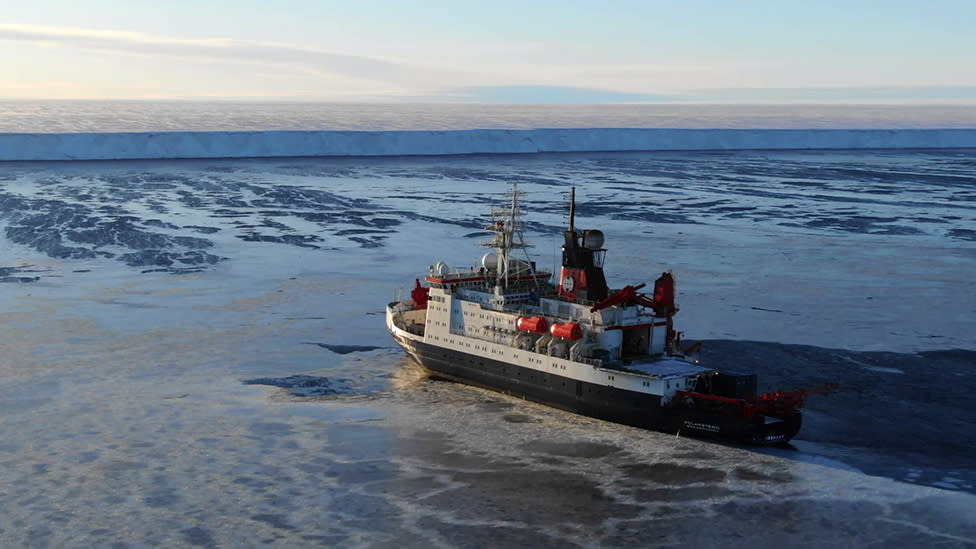Life gets busy where it can, even under a thick layer of ice in Antarctica.
German scientists inspected an area of the seabed newly exposed by the birth of the mega-iceberg A74 and found that it was full of animals.
Video cameras tracked abundant filter feeders thriving among the soft sludge.
It was a remarkable opportunity for the team, as their ship, RV Polarstern, crossed the still narrow gap that exists between the A74 and the Brunt ice shelf, which produced the giant iceberg.

Research groups often try to probe the waters below the newly-formed ice platforms, to better understand how these unique ecosystems operate. But success is not easily achieved.

You have to be in the right place in Antarctica at the right time, and often, sea ice conditions simply do not allow a research ship to position itself above the destination.
But Polarstern, run by the Alfred Wegener Institute, was lucky. He was already in the east of the Weddell Sea, on a pre-planned expedition, when the city-sized A74 separated from Brunt.
And when the weather calmed down last weekend, the ship slid behind the iceberg to take a look at an area of the seabed that is now free of ice for the first time in five decades.

Polarstern employs an Ocean Floor Observation and Bathymetry System (OFOBS). This is a sophisticated instrument package that is towed behind the ship in depth.
In five hours, the system collected nearly 1,000 high-resolution images and long video streams.
“Despite years of continuous ice cover, a developed and diverse community on the sea floor has been observed,” said Dr. Autun Purser and Dr. Frank Wenzhoefer, members of the OFOBS team.
“In the images, several sessile animals can be seen attached to several small stones spread freely across the soft seabed.
“Most of them are organisms that feed on filters, supposedly subsisting on thin material transported under the ice in recent decades.
“Some mobile faunas, such as holoturics, ophiuroids, various molluscs, as well as at least five species of fish and two species of octopuses have also been observed.”

Dr Huw Griffiths, from the British Antarctic Survey, was thrilled to see the photos sent from Polarstern.
“What they found is not shocking, but it is incredible to obtain these images right after delivery and it is definitely the largest area that will have been researched in this way,” he commented.
“Finding this type of community so far below the ice shelf is not surprising, but it is a good indication that there is a rich supply of food reaching at least 30 km under the ice shelf.
“This food is produced by plankton on the nearby sunlit sea surface and then dragged down the ice shelf by the currents of the Weddell Sea. These same currents will eventually move the iceberg west around the Sea. from Weddell and then north to your destination, “he told BBC News.

From the research point of view, the idea would be to return at regular intervals to document any changes in the ecosystem.
This is something Polarstern could do because AWI is conducting long-term studies in the region.
The eastern side of the Weddell Sea is interesting because it has not witnessed the effects of warming that have been observed in its western sector, close to the Antarctic Peninsula.
This situation may not last, however, with computer models suggesting that there could be regular incursions of warm water from the northern ocean towards the end of the century.

Where is that in Antarctica?
The A74 separated from the Brunt ice shelf, which is the floating lump of glaciers that flowed from the land into the Weddell Sea. On a map, the Weddell Sea is that sector of Antarctica directly south of the Atlantic Ocean. The Brunt is on the east side of the sea. Like all ice rigs, it periodically creates icebergs. A large iceberg appeared for the last time in this specific area in 1971.
What is the size of the A74 iceberg?
The satellite’s measurement puts it at about 1,290 km2 (500 square miles). Greater London is approximately 1,500 square kilometers; the Welsh county of Monmouthshire is about 1,300 square kilometers. This is big by any measure, although not as big as the A68 iceberg monster, which spawned in July 2017 on the Larsen C ice shelf on the west side of the Weddell Sea. This was originally about 5,800 square kilometers, but has since broken into many small pieces.

